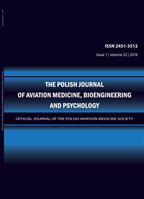2022, Volume 28, Issue 3
MANAGEMENT OF MILITARY PILOTS WITH CORONARY ARTERY DISEASE AND CORONARY ARTERY ANOMALIES IN THE CONTEXT OF NEW MEDICAL CERTIFICATION REGULATIONS IN POLAND
MICHAŁ A. KUREK1, MAGDALENA ROLA2, ŁUKASZ DZIUDA3
-------------------------------------------------------------------------------------------------
1Department of Internal Disease, Military Institute of Aviation Medicine
2Military Aviation Medical Board
3Department of Psychophysiological Measurements and Human Factor Research, Military Institute of Aviation Medicine
Autor korenspondencyjny: MICHAŁ A. KUREK; Department of Internal Disease, Military Institute of Aviation Medicine; email: mkurek@wiml.waw.pl
Full text
Streszczenie
Introduction: Coronary artery disease constitutes one of the most significant health threats for experienced pilots over the age of 35. Until recently, a diagnosis of this disease in Poland resulted in the disqualification of a military pilot from flying. On 5 December 2023, significant amendments were introduced to the Regulation of the Minister of National Defence concerning the assessment of fitness for military service, which are of particular importance to military aviation. One of the key amendments is the possibility for pilots with coronary artery disease to continue flying duty. The aim of this article is to analyze the new regulations in the context of available scientific data and their practical implications for aviation medicine.
Methods: A comprehensive literature review was conducted using electronic databases such as PubMed® and Google Scholar, focusing on coronary artery disease and coronary anomalies, particularly within military populations. The search included keywords such as: “coronary artery disease,” “coronary syndrome,” “myocardial infarction,” “coronary artery anomalies,” and “aerospace medicine.” Relevant studies addressing coronary artery disease in the context of military medical certification were included, and the latest clinical guidelines issued by aerospace medicine regulatory authorities were analyzed in order to provide context for the management of coronary artery disease and coronary artery anomalies in pilots.
Results: The annual risk of a “cardiac event” for a male military pilot aged 35–54 is 0.15%, with myocardial infarction being the first manifestation in 34% of cases. Research data highlight the need for a comprehensive risk assessment in pilots with coronary artery disease, taking into account not only the degree of anatomical coronary artery stenosis but also functional tests demonstrating ischemia, as well as the summed stenosis score, which is a better predictor of cardiac events than isolated stenoses. Following a detailed cardiological evaluation and the fulfillment of specific criteria, a return to flying duty is possible six months after a myocardial infarction. Congenital coronary artery anomalies, present in approximately 1% of adults, usually do not affect health. However, certain anomalies—such as the anomalous origin of the left coronary artery from the pulmonary artery (ALCAPA) or anatomical abnormalities of coronary artery origins (AAOCA, anomalous aortic origin of a coronary artery)—can lead to serious symptoms and are considered a disqualifying factor for flying duties. Functional assessment of these anomalies to rule out myocardial ischemia is essential.
Conclusions: The conclusions emphasize the necessity of individualized risk assessment, taking into account the pilot’s role within the flight crew and the specific conditions of flight operations. The changes introduced in Polish regulations are consistent with widely accepted international standards, while also presenting new diagnostic and certification challenges for physicians.
Słowa kluczowe
coronary artery disease, coronary syndrome, myocardial infarction, coronary artery anomalies, aerospace medicine, military medical assessment
